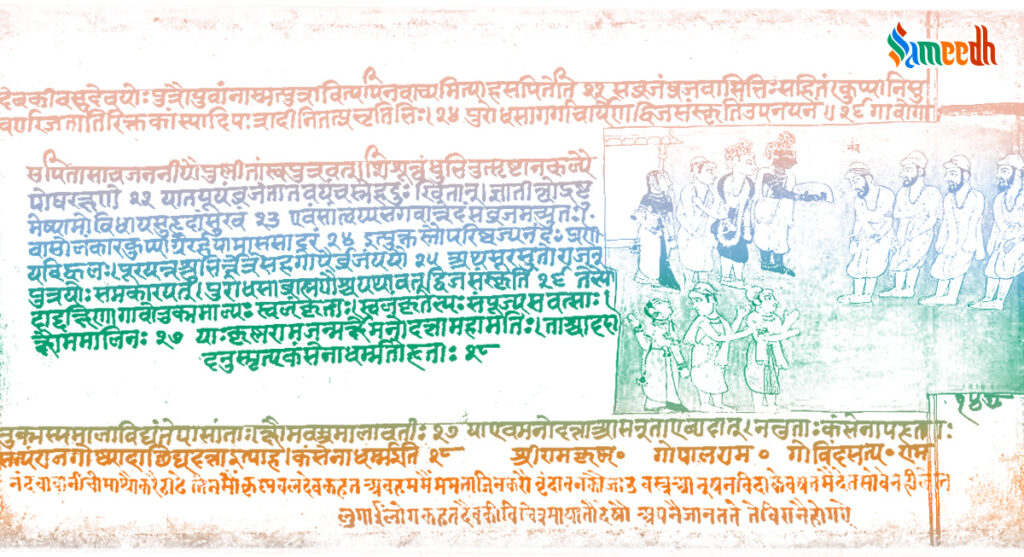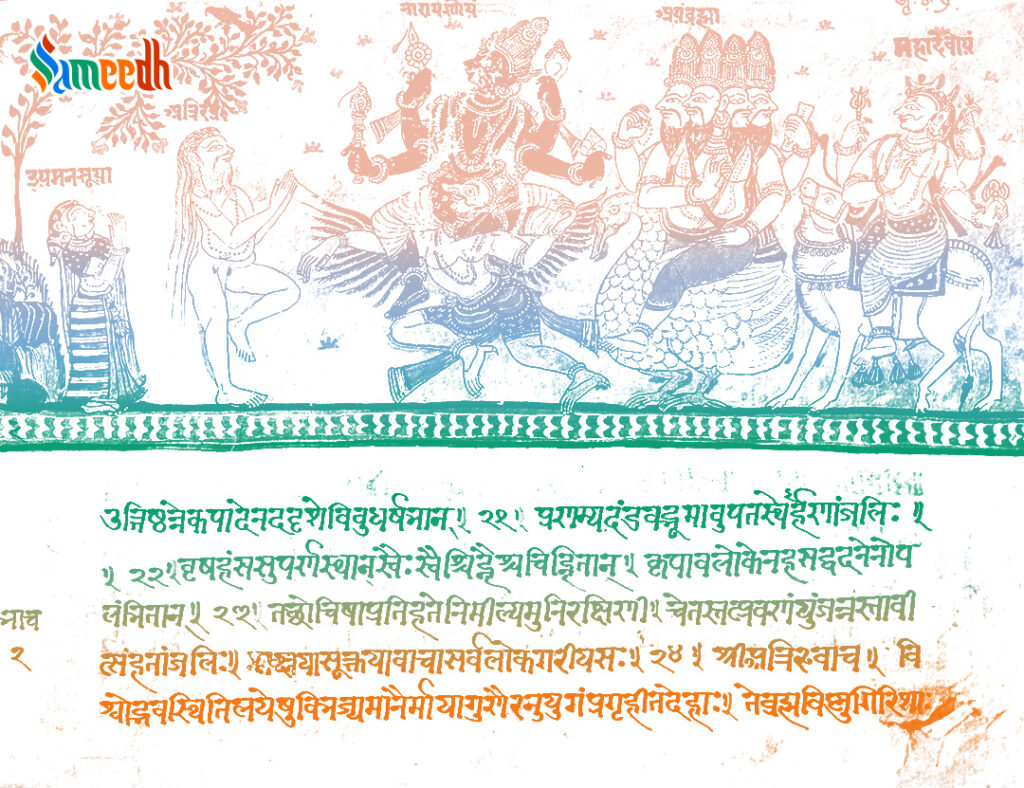The Bhagavat Puran primarily focuses on the life and teachings of Lord Krushna, one of the most revered deities in Hinduism. It includes various stories and episodes related to Krushna’s childhood, youth, and his role in the Mahabharat, especially the Bhagavad Gita. The text also covers cosmology, genealogies, and the concept of Bhakti (devotion) as the path to salvation.

Page From Bhagvad Puran; Image Source: The Met
The Hindu ideology is largely influenced by its epics, scriptures, and the Mahapurans, or the Smritis. They are a body of ancient texts which have been written by great sages or passed down from generation through generation. An example of such a Puran is the Bhagavad Puran. Many people confuse the Bhagavad Puran with the Devi Bhagavad or the Shrimad Bhagavad Gita. The Bhagavad Puran is different from all of these. It talks about all things Vishnu and states that in the end there is only one truth to life and that is: Krushna. It starts with the war of the Gods and the Demons. When the evil takes over the Gods, truth, or Krushna, emerges in the world, who then defeats the demons to bring happiness, peace, and prosperity back into the land.
The History
Said to be composed by Ved Vyas between the 6th to 8th century BCE, he taught it to his son Suka, who then narrated it to the heir of Yudhisthir, son of Uttara, King Parikshit. It is the true expression of devotion. The Srimad Bhagavatam’s 18,000 words are made up of a series of interrelated, interlaced, and non-linear discussions, teachings, and explanations of Bhakti Yoga that go back and forth in time and across the books.
The text is divided into twelve books (skandhas), each with 332 chapters (adhyayas) and 16,000 to 18,000 verses, depending on the recension. The tenth book, which contains roughly 4,000 verses, is the most well-known and researched. It was the first Purana to be translated into a European language. When a French translation of a Tamil version was published in 1788, it introduced many Europeans to Hinduism and 18th-century Hindu culture during the colonial period.

Bhagwad Puran Manuscript; Image Source: Bhakti Vedanta Research Centre
Why Should You Read It?
All Purans in general describe
(1) The Universe’s Creation
(2) Genealogy and Destruction
(3) Dynasties
(4) Manvantaras
(5) Dynastic Chronicles.
The Bhagavad Puran is all that and more. It describes the journey of Krushna. The main objective of this book is devotion, or bhakti, to Vishnu. The book holds all the secrets, life stories, and messages of the life of Vishnu or Krushna. The story of a young Krushna, Krushna as a lover, and Krushna the cowherd is told in the Bhagavata Purana. In this book, the practice of Bhakti Yoga places a special emphasis on cultivating transcendental loving devotion to Krushna as the ultimate good, i.e. for its own sake rather than for fruitive effects or rewards such as detachment or worldly or heavenly benefits.
The Bhagavata Purana expounds on various theological and philosophical concepts, including the nature of the divine, the concept of Brahman, the manifestations of God (Vishnu and Krushna), and the importance of devotion (Bhakti) as a means of attaining liberation (moksh).
The Bhagavata Purana is rich with diverse stories that cover various aspects of Hindu mythology, philosophy, and spirituality. Here are some notable stories from the Bhagavata Purana:
- Creation of the Universe (Canto 3): The Bhagavata Purana describes the creation of the universe, detailing the process of cosmic evolution, the emergence of various elements, and the manifestation of different beings.
- The Story of Dhruv (Canto 4): The tale of Dhruv, a young prince who, through intense penance and devotion, attains the boon of becoming the eternal pole star. His story illustrates the power of unwavering determination and devotion to God.
- Prahlad and Hiranyakashipu (Canto 7): This famous story of Prahlad, a devoted young boy, and his demoniac father, Hiranyakashipu. Despite facing severe persecution from his father, Prahlad remains devoted to Lord Vishnu, who eventually appears in the form of Narasimha (half-man, half-lion) to protect Prahlad.
- The Churning of the Ocean (Canto 8): The Samudra Manthan is a significant episode where the Devs (celestial beings) and Asurs (demons) collaborate to churn the ocean to obtain the nectar of immortality (amrit). This story involves the emergence of various divine entities, including the goddess Lakshmi.
- Lord Ram’s Story (Canto 9): The Bhagavat Puran includes a condensed version of the Ramayan, focusing on the life and adventures of Lord Ram, an incarnation of Lord Vishnu. It narrates Ram’s exploits, his exile, the abduction of his wife Sita by Ravan, and the eventual victory of good over evil.
- Krushna’s Childhood and Youth (Canto 10): The tenth book of the Bhagavata Purana is dedicated to the life and teachings of Lord Krushna. It includes stories of Krushna’s childhood escapades, his divine sports (leelas), and his role in the Mahabharat, including the famous Bhagavad Gita discourse to Arjun.
- Uddhava Gita (Canto 11): Towards the end of the Bhagavat Puran, there’s a section known as the Uddhav Gita, a conversation between Lord Krushna and his devotee Uddhav. It delves into profound philosophical and spiritual teachings, emphasizing the path of devotion and the nature of ultimate reality.
These stories, among others, contribute to the Bhagavata Purana’s reputation as a comprehensive scripture that combines mythology, philosophy, and devotion, providing spiritual guidance to followers of Hinduism. Each narrative serves a specific purpose, conveying moral, ethical, and metaphysical lessons.
The reference to “Canto 3” in the context of the Bhagavat Puran signifies a specific section or chapter within the larger text. The Bhagavata Purana is divided into twelve books or cantos, each known as a “Skandha.”
The Bhagavat Puran has had a profound influence on the devotional traditions within Hinduism, particularly the Bhakti movement. It emphasizes the worship of Lord Krushna and the chanting of his holy names as a means of spiritual elevation.
The Bhagavat Puran is widely studied and revered by followers of Hinduism for its spiritual and philosophical teachings, as well as its rich narrative content. It continues to be an essential scripture in the religious and cultural life of millions of people.